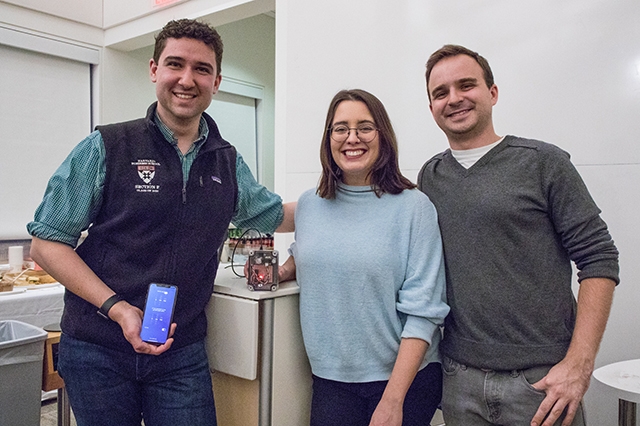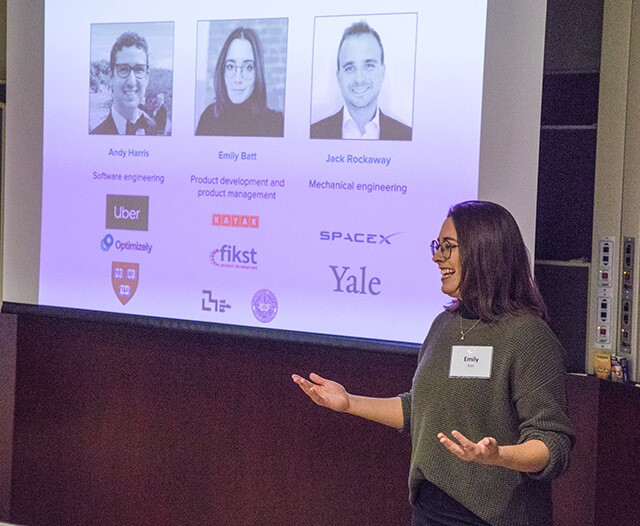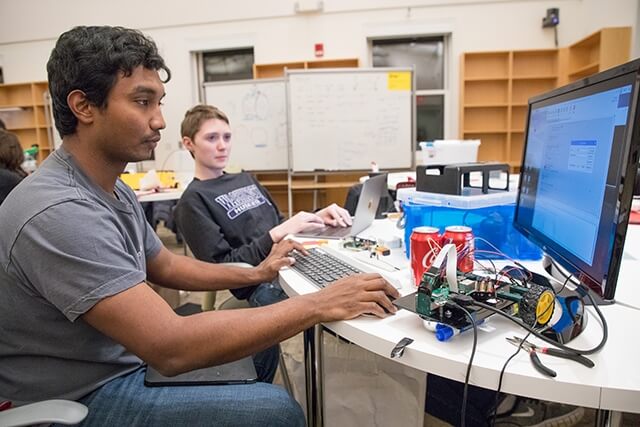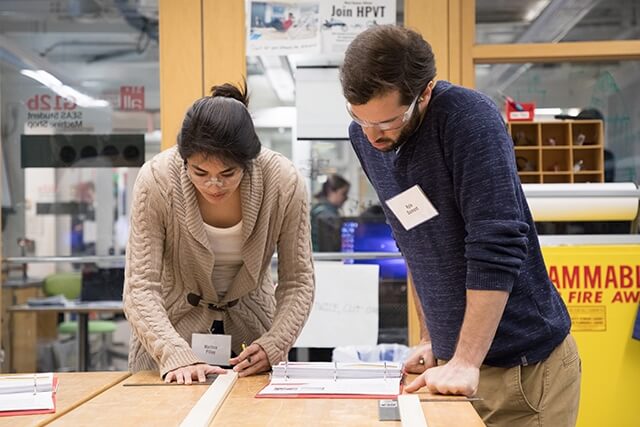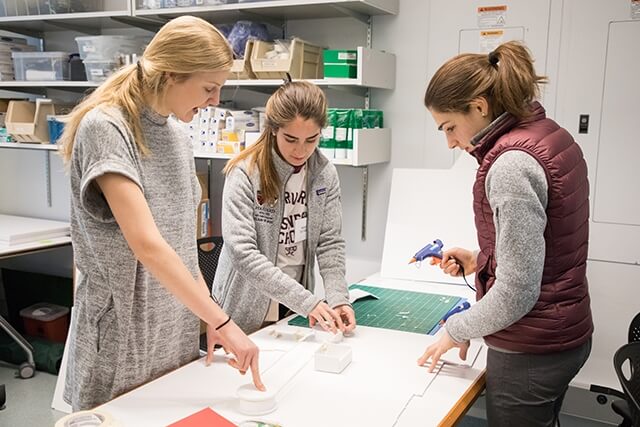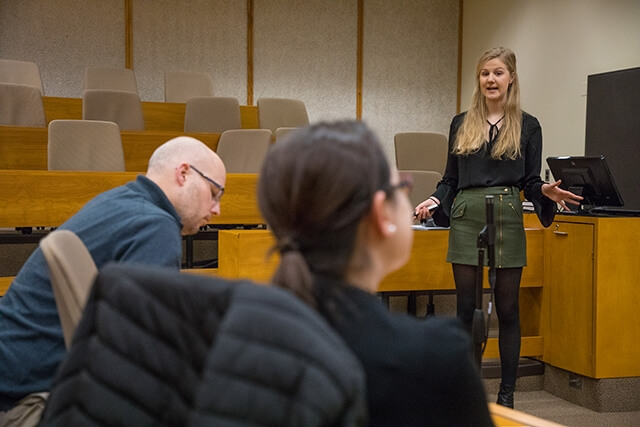News
Lying in bed each morning, listening to the water run as her roommate took a seemingly endless shower, Emily Batt felt a mixture of frustration and exhaustion. She wanted to be able to sleep until the shower was free, but had no way of knowing when her less-than-considerate roommate would vacate the bathroom.
Those frustrating mornings served as motivation during a team project in the Technology Venture Immersion (TVI) program, a unique, two-week course in the University’s new MS/MBA program, jointly offered by the John A. Paulson School of Engineering and Applied Sciences and Harvard Business School.
Batt’s team created a connected device and app that delays a smartphone alarm from sounding until the shower is empty. During the first week of TVI, the team buckled down during a series of fast-paced work session in the SEAS Active Learning Labs, developing electronic sensors, crafting a watertight chassis, designing WiFi components, and producing an alarm-sounding app.
Teammates Andy Harris, Emily Batt, and Jack Rockaway developed this connected device and app that delays a smartphone alarm from sounding until the shower is empty. (Photo by Eliza Grinnell/SEAS Communications)
“Working under such a tight timeline definitely helps you prioritize,” said Batt, an engineer with a project management background. “It was pretty remarkable that we were able to complete a proof of concept prototype, with hardware and software, in only three days. I think that’s my fastest turnaround time ever.”
Prototype in hand, the team spent the second week of TVI at the Harvard Innovation Labs, where they crafted a pitch for a startup that would manufacture and sell the device.
As the teammates huddled over laptops, creating slides and hammering out details for a presentation they hoped would impress a panel of venture capital investors and seasoned entrepreneurs, they were forced to apply problem-solving skills in very different ways.
“As scientists, we try to poke holes in our hypotheses. For engineers, it is painful to operate in a space without a lot of data,” said Jack Rockaway, who worked as a SpaceX propulsion engineer before joining the MS/MBA program. “From an engineering background, more charts and more information is always better, but that is not the takeaway here. We are supposed to show charisma and an ability to convince people to do things.”
TVI combines an intensive immersion into design and rapid prototyping and broad exposure to the challenges of designing a new venture’s business model. The course was co-developed and is taught by Tom Eisenmann, Howard H. Stevenson Professor of Business Administration, with Conor Walsh, Gordon McKay Professor of Engineering and Applied Sciences.
Batt pitches her team's startup to a panel of business experts. (Photo by Eliza Grinnell/SEAS Communications)
From conceiving and building a proof-of-concept prototype, to applying design principles to a new venture’s business model, students found themselves drawing on different skill sets and applying unique approaches in the space of only two weeks.
“I’m not aware of other courses that emphasize this level of integration between technical and business aspects when teaching students to apply design principles,” Eisenmann said. “Likewise, the course’s compressed two-week time frame simulates the time pressure that teams often encounter in technology ventures. The tight time frame also builds students’ confidence by demonstrating how much they can accomplish in a short period.”
Immersion was more than just the course’s title—it was literally how the course began.
Students hit the ground running at SEAS, where they immediately got their hands dirty through ‘crash courses’ on laser cutters, 3D printers, microprocessors, sensors, actuators, algorithm development and other tools that would be critical during the prototyping phase of their team projects.
Given their diverse technical backgrounds, the goal for the labs was to provide quick design exercises that exposed students to mechanical, electrical and programming prototyping tools and skills. The students drew on a common understanding for their team projects to rapidly prototype “minimal viable products” (MVPs) for their venture concepts.
For Sabareesh Chinta, a former Apple electrical engineer, rapidly attacking a mechanical engineering problem in a compressed timeframe was a change of gears that proved tougher than he expected.
Sabareesh Chinta (foreground) works on the prototype for his team's project. (Photo by Eliza Grinnell/SEAS Communications)
“The biggest challenge has been trying to simplify our thoughts. You could end up building something much more complicated only to realize you didn’t need it,” he said. “For me, the biggest takeaway from this is an understanding that, if you want to test a design, you don’t have to build it out. You don’t have to take 10 months and a team of engineers to answer a few simple questions.”
Chinta and his classmates put those rapid prototyping skills to use as they teamed up to design and build tech products, choosing from a set of suggested projects.
Martina Pillay and her teammates chose to develop an automatic plant watering system, which sensed the moisture content of soil and automatically dispensed water when it became too dry.
For Pillay, a bioengineer with experience in business intelligence, diving headfirst into a demanding hardware and circuitry problem was uncomfortable at first, but she developed confidence in her abilities to work quickly.
As they fine-tuned their prototype, the team faced the constant threat of scope creep. It would have been easy to get excited about the prototype and want to add more features, Pillay said, but they needed to tightly manage their time.
Martina Pillay and teammate Kyle Dumont take careful measurements in the Active Learning Labs wood shop. (Photo by Eliza Grinnell/SEAS Communications)
“I hope to use these skills to one day start a venture in digital health,” she said. “Not only did this program teach us how to build basic prototypes, but also how to define a problem, design and scope a minimum viable product, and work with a cross-functional team to build a prototype and business model. These basic skills we learned over just a few days will be extremely helpful in the long term to build products and companies.”
Those lessons learned and experiences in TVI will serve as a prelude for what is to come as students progress through the MS/MBA program.
“We hope that students gained an appreciation for many of the different aspects to consider when launching a technology-focused new product or venture,” Walsh said. “For example, on the technical side, it involves prioritizing features, considering many system-level trade-offs, following a product development process, communication, and managing multidisciplinary technical teams.”
After being immersed in the technical side of a technology-focused product, students were plunged into the world of entrepreneurship during TVI’s second week.
Teammates Mollie Breen, Valentina Villagra, and Emily Gould collaborate to createa a rapid prototype. (Photo by Eliza Grinnell/SEAS Communications)
Teammates Lucy Lee and Mollie Breen drew on the rapid prototyping skills and product development experience they gained during the first week as they put together a pitch for their startup, Brandentity. They conceived a brand voice optimization platform that uses artificial intelligence, machine learning, and natural language processing to help marketers predict how certain social media posts will impact their brand’s reputation.
While week one of the TVI program helped computer scientist Breen overcome her fear of hardware, the second week taught her the underappreciated value of soft skills. She and Lee spent much of their time communicating with potential customers to understand their needs, building that feedback into a simple and straightforward pitch.
For Breen, it was surprising to learn that the delivery of a pitch is just as important as the content.
“I really learned the importance of humility,” she said. “There is a lot of ego built around entrepreneurship. We’ve learned that it is important to be realistic about your projections and really confident as well.”
As Breen and Lee introduced Brandentity to mentors Mar Hershenson, managing partner at Pear Venture Capital, and Luke Porisch, S.M. ’05, vice president at St. Ansgar State Bank, they were careful to stick to a simple script.
Breen pitches Brandentity to mentors Mar Hershenson and Luke Porisch, S.M. ’05. (Photo by Eliza Grinnell/SEAS Communications)
The pitch presentations showcased how students were able to learn new skills and put them into practice quickly and effectively. What were very wobbly startup pitches mid-week were polished and persuasive presentations by Friday, thanks to the feedback from mentors and the remarkable progress the students made addressing the issues their mentors raised, Eisenmann said.
“The combined technical and business backgrounds and training of the MS/MBA students really stood out,” Walsh said. “They were able to rapidly understand problems, define opportunities, and execute to create functional proof of concept prototypes and investor pitch decks, all over the course of two weeks.”
He and Eisenmann agree that those skills will prove invaluable as students dive deeper into the MS/MBA program, encountering challenges of increasing scope and complexity.
Topics: Academics
Cutting-edge science delivered direct to your inbox.
Join the Harvard SEAS mailing list.
